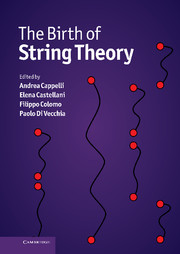Book contents
- Frontmatter
- Contents
- List of contributors
- Photographs of contributors
- Preface
- Abbreviations and acronyms
- Part I Overview
- EARLY STRING THEORY
- Part II The prehistory: the analytic S-matrix
- 5 Introduction to Part II
- 6 Particle theory in the Sixties: from current algebra to the Veneziano amplitude
- 7 The path to the Veneziano model
- 8 Two-component duality and strings
- 9 Note on the prehistory of string theory
- Part III The Dual Resonance Model
- Part IV The string
- TOWARDS MODERN STRING THEORY
- Part V Beyond the bosonic string
- Part VI The superstring
- Part VII Preparing the string renaissance
- Appendix A Theoretical tools of the Sixties
- Appendix B The Veneziano amplitude
- Appendix C From the string action to the Dual Resonance Model
- Appendix D World-sheet and target-space supersymmetry
- Appendix E The field theory limit
- Index
8 - Two-component duality and strings
from Part II - The prehistory: the analytic S-matrix
Published online by Cambridge University Press: 05 May 2012
- Frontmatter
- Contents
- List of contributors
- Photographs of contributors
- Preface
- Abbreviations and acronyms
- Part I Overview
- EARLY STRING THEORY
- Part II The prehistory: the analytic S-matrix
- 5 Introduction to Part II
- 6 Particle theory in the Sixties: from current algebra to the Veneziano amplitude
- 7 The path to the Veneziano model
- 8 Two-component duality and strings
- 9 Note on the prehistory of string theory
- Part III The Dual Resonance Model
- Part IV The string
- TOWARDS MODERN STRING THEORY
- Part V Beyond the bosonic string
- Part VI The superstring
- Part VII Preparing the string renaissance
- Appendix A Theoretical tools of the Sixties
- Appendix B The Veneziano amplitude
- Appendix C From the string action to the Dual Resonance Model
- Appendix D World-sheet and target-space supersymmetry
- Appendix E The field theory limit
- Index
Summary
The Veneziano model [Ven68], the starting point of string theory, addressed the at that point much studied and phenomenologically successful idea of ‘two-component duality’. Here I would like to recall this idea and give its meaning in modern terms. At the risk of letting the cat out of the bag at too early a stage, let me say right away that the two components in question will turn out to be the open and the closed hadronic strings.
The argument for two-component duality is the following. Unlike quarks, hadrons (mesons and baryons) are obviously not elementary objects. Yet the particles appearing in the initial, final and intermediate states of the hadronic S-matrix, describing all quantum processes involving hadrons, are precisely these composite objects and not their constituent quarks. With elementary particles it is obvious how to calculate the S-matrix, just use the Feynman rules. For instance, when studying lowest order (tree-level) Bhabha scattering (i.e. electron–positron scattering) in QED, we are instructed to add the socalled s- and t-channel photon-pole Feynman diagrams, as in Figure 8.1. But there we have a Lagrangian and the photon is an ‘elementary’ particle whose field appears in this Lagrangian.
When dealing with composite states, these are represented by an infinite sum of Feynman diagrams in the quantum field theory of the elementary fields out of which the composite particles are built. In the simplest case we can think of these diagrams as Bethe–Salpeter ladder-diagrams.
- Type
- Chapter
- Information
- The Birth of String Theory , pp. 122 - 128Publisher: Cambridge University PressPrint publication year: 2012
- 1
- Cited by



